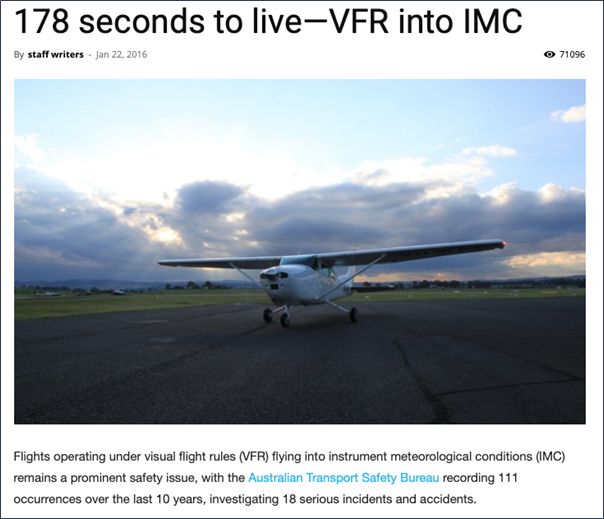Night VFR
05/30/23 02:40:pm
Night VFR is a misnomer; it is not only contradictory but highly dangerous as a regulatory oversight. It has resulted in many fatal accidents and will no doubt be the causal factor in many more.
The following extract from CASR AC 61-05V1.1 is self-deprecating and self-explanatory.
Night Visual Flight Rules 2.1.1 Flight operations conducted at night under VFR – also known as NVFR operations – are not a common practice internationally, mainly due to weather and terrain factors. Flight at night is more commonly conducted under instrument flight rules (IFR).
Night Visual Flight Rules (NVFR) in Australia refer to the regulations and procedures that govern flying an aircraft at night under visual meteorological conditions (VMC). NVFR allows pilots to operate aircraft outside of daylight hours when the weather conditions and visibility are suitable for visual flight.
Some key points regarding NVFR operations in Australia:
1. Eligibility: To fly under NVFR in Australia, pilots must hold a Private Pilot License (PPL) or a higher-level license. Additionally, they must have completed specific training and received an NVFR rating.
2. Requirements: Pilots must meet certain requirements to conduct NVFR operations, including a minimum flight experience, instrument flight training, and night flight training. They must also pass a theoretical examination and a flight test.
3. Aircraft Equipment: The aircraft used for NVFR operations must meet certain equipment requirements, such as having a minimum set of instruments and lighting systems for night flight.
4. Weather Conditions: NVFR flights can only be conducted in visual meteorological conditions (VMC) during the night. The visibility and cloud ceiling requirements for NVFR differ from those of daytime VFR operations.
5. Navigation: NVFR flights may require pilots to navigate using visual reference points, navigation aids, and suitable charts. Proper navigation planning, including identifying landmarks and checkpoints, is crucial.
6. Lighting Requirements: Aircraft operating under NVFR must have appropriate lighting, including navigation lights, anti-collision lights, and position lights. Pilots must ensure the aircraft's lights are functioning correctly and comply with relevant regulations.
7. Visual Approach: During NVFR operations, pilots must conduct visual approaches and maintain visual contact with the ground and other obstacles. The use of visual aids, such as runway lighting and approach lighting systems, is essential for safe landings.
It is common knowledge that visual conditions at night can change without warning e.g., a cloud layer or dust can reduce visibility leading to the equivalent of IFR conditions. If the pilot is not instrument rated, then there is only one sad outcome aptly described in the publication link below.
https://www.flightsafetyaustralia.com/2016/01/178-seconds-to-live-vfr-into-imc/
#aviation #safety #VFR #NVFR #flightsafety

Latest News
Projects
- ZS-NRM Accident Analysis
- UKCAA CAP437 Update
- CAP437 Inspections & Friction Tests
- Aviation Risk in Numbers
- Integrated Safety/Quality Course
- Friction Testing of Helidecks
- AIIA Course
- Amy Johnson - Pioneering Aviator
- Safety First!
- Risk Management in Aviation
- OMWIT Training
- eVTOL
- CASA (VDOTWG)
- Independent Aviation Auditing
- Converting Helipads to Vertiports
- Next HIAT Course
- The Flight Safety Group
- Emerging Trends in Auditing
- Night VFR
- Top 5 Safety Measures
- The Role of Auditing
- Emergency Response
- Flight Safety Group
- Single Pilot Ops
- Safety Culture
- Helideck Obstructions
- CASA Part 133
- World's First Flying Car
- Vertiport Safety Training Course
- Humanoid Robot Pilot
- The Benefits of Using Drones


